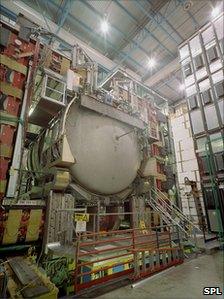Antimatter Tevatron mystery gains ground
- Published

The Dzero team is also part of a mystery about a potential new particle
US particle physicists are inching closer to determining why the Universe exists in its current form, made overwhelmingly of matter.
Physics suggests equal amounts of matter and antimatter should have been made in the Big Bang.
In 2010, researchers at the Tevatron accelerator claimed preliminary results showing a small excess of matter over antimatter as particles decayed.
The team has showing those results are on a firmer footing.
Each of the fundamental particles known has an antimatter cousin, with identical properties but opposite electric charge.
When a particle encounters its antiparticle, they "annihilate" each other, disappearing in a high-energy flash of light.
The question remains: why did this not occur in the early Universe with the equal amounts of matter and antimatter, resulting in a Universe devoid of both?
New physics?
The Tevatron results come from a shower of particles produced at the facility when smashing protons into their antimatter counterparts, antiprotons.
The proton-antiproton collisions in turn create a number of different particles, and the team operating the Tevatron's DZero detector first noticed a discrepancy in the decay of particles called B mesons.
These decayed into pairs of particles called muons alongside pairs of their antimatter versions, antimuons. But, as the team reported in May 2010 in a , there was a notable 1% excess of the matter particles.
However, unpicking important events in the soup of interactions created in particle physics experiments meant that those measurements were associated with a level of uncertainty - reflecting the probability that the effect they see is a random statistical occurrence, rather than new physics.
The researchers now have 50% more data to work with, and have tried to establish that their earlier result in fact came from the particle decays that they first proposed.
As they reported this Thursday, they have now reduced the uncertainty in their experiment to a level of "3.9 sigma", or 3.9 standard deviations - equivalent to a 0.005% probability that the effect is a fluke.
But particle physics has a strict definition for what may be called a discovery - the "five sigma" level of certainty, or about a 0.00003% chance that the effect is not real - which the team must show before they can claim to have solved the long-standing matter/antimatter mystery.
- Published12 June 2010
- Published15 June 2011
- Published10 June 2011